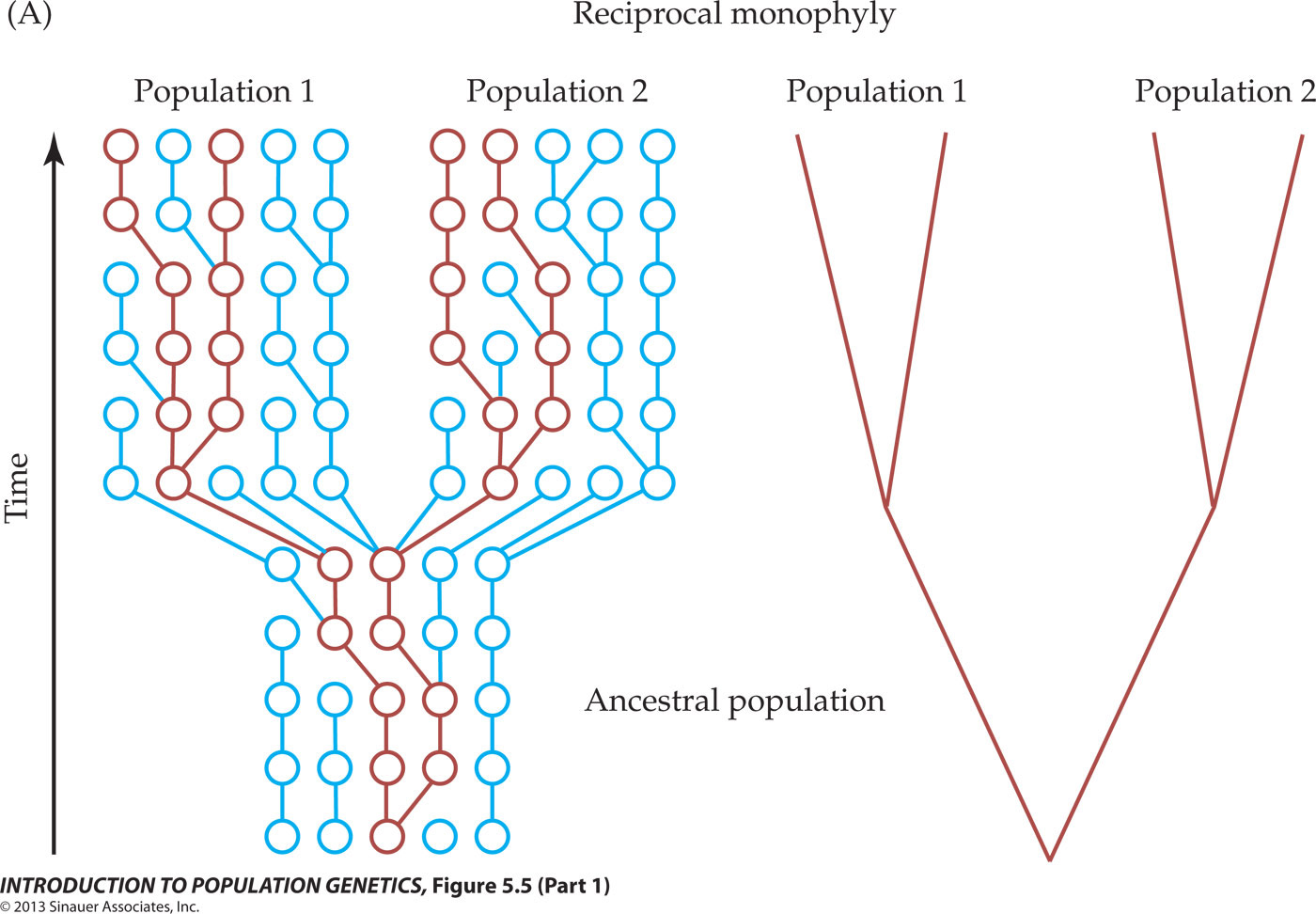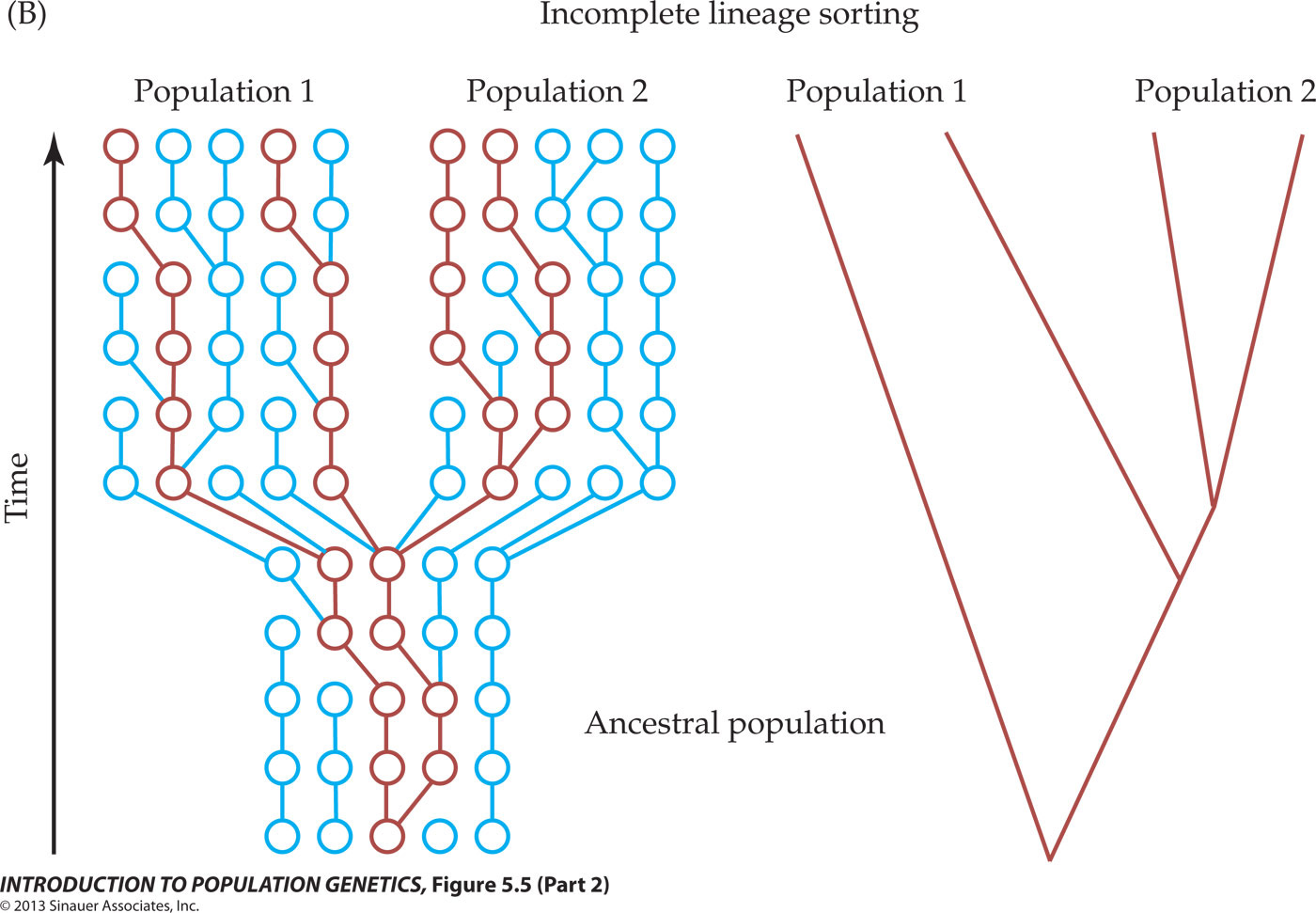

Two patterns of genetic coalescence in separating populations / species
Loosely, Monophyly is the concept that
all species in a given taxon (genus, family, order,
etc.) share a common ancestor. However, since all
species anywhere eventually share a common ancestor in
geological history, the idea must be more carefully defined in
any particular context.
In phylogenetic systematics, a monophyletic group is defined as one comprising two or more species and their most recent common ancestor (MRCA). A monophyletic taxon [a named taxonomic group, like Homo, Hominidae, Primata, Mammalia, etc] is one that comprises a monophyletic set of species, including their most recent ancestor. [Monophyly defined in this way is sometimes called Holophyly, to distinguish it from a group comprising an MRCA but not all of its descendants].
The concept also applies to populations within species. Figure (A) illustrates the concept of Reciprocal Monophyly. Between populations, Reciprocal Monophyly occurs where the two marked lineages in Population1 (1 & 3) and those in Population 2 (1 & 2) both share MRCAs with each other than either does with either member of the other pair. That is, the lineages in either population are monophyletic with respect to the other.
Figure (B) illustrates the concept of Incomplete Lineage Sorting. The same two lineages in Population 2 are monophyletic as before. However, lineages 1 & 4 in Population 1 do not share an MRCA within Population 1, but only in the very oldest (bottom) generation shown. Lineage 4 in Population 1 in fact has an MRCA with the pair in Population 2 in the seventh generation backward from the present, which is more recent than the MRCA in Population 1. That is, the five lineages in the Ancestral Population have not sorted completely such that all lineages in Population 1 are reciprocally monophyletic to all of those in Population 2.
HOMEWORK: Consider Lineages 2, 4, & 5 in Population 1, and 3, 4, & 5 in Population 2. Analyze how their coalescent histories affect the nature of Populations 1 & 2 as distinct biological species.
In phylogenetic systematics, a monophyletic group is defined as one comprising two or more species and their most recent common ancestor (MRCA). A monophyletic taxon [a named taxonomic group, like Homo, Hominidae, Primata, Mammalia, etc] is one that comprises a monophyletic set of species, including their most recent ancestor. [Monophyly defined in this way is sometimes called Holophyly, to distinguish it from a group comprising an MRCA but not all of its descendants].
The concept also applies to populations within species. Figure (A) illustrates the concept of Reciprocal Monophyly. Between populations, Reciprocal Monophyly occurs where the two marked lineages in Population1 (1 & 3) and those in Population 2 (1 & 2) both share MRCAs with each other than either does with either member of the other pair. That is, the lineages in either population are monophyletic with respect to the other.
Figure (B) illustrates the concept of Incomplete Lineage Sorting. The same two lineages in Population 2 are monophyletic as before. However, lineages 1 & 4 in Population 1 do not share an MRCA within Population 1, but only in the very oldest (bottom) generation shown. Lineage 4 in Population 1 in fact has an MRCA with the pair in Population 2 in the seventh generation backward from the present, which is more recent than the MRCA in Population 1. That is, the five lineages in the Ancestral Population have not sorted completely such that all lineages in Population 1 are reciprocally monophyletic to all of those in Population 2.
HOMEWORK: Consider Lineages 2, 4, & 5 in Population 1, and 3, 4, & 5 in Population 2. Analyze how their coalescent histories affect the nature of Populations 1 & 2 as distinct biological species.
Figures © 2013 by Sinauer; Text material © 2018 by Steven M. Carr